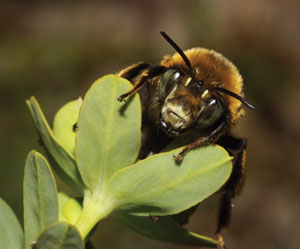Cornell entomologists ponder the pollinators
Cornell entomologists ponder the pollinators
Late last April, as buds swelled in the Cornell Orchards, E. J. Blitzer tied gauzy fabric bags—intended by their manufacturer to wrap wedding favors—over select apple branches to insure that insects wouldn't have access to the blooms. The twenty-nine-year-old postdoc intended to strictly manage pollination; as each blossom unfurled over the subsequent two weeks, she opened its bag and generously dusted the anthers inside. "In real life, you don't have a person with a paintbrush," Blitzer muses. "You have a bee moving the pollen from blossom to blossom."
This fall, as Empire State growers picked more than 25 million bushels of apples—a harvest second only to that of Washington State and a contribution of some $261 million annually to New York's economy—Blitzer returned to the seventy-five trees she'd pollinated to collect the fruit of her labors and assess its quality and quantity. The experiment, which also included an assessment of the fruit from seventy-five trees pollinated by whichever insects happened to alight on their blooms, was part of an ongoing analysis of the agricultural contributions of an array of indigenous species in New York State orchards, headed by entomology professor Bryan Danforth, Blitzer's adviser.

One in every three bites we raise to our mouths—everything from apples to zucchini, with stops along the way for blueberries, melons, pumpkins, and more—can be credited to the pollinating prowess of myriad insects. Apis melifera, the fuzzy, black-and-yellow honeybee beloved for its gentle disposition and the sweet golden syrup it produces, has long been lauded as the workhorse of the insect pollination circuit. And while that species has taken the limelight since colony collapse disorder hit in 2007, Danforth suspects that in the U.S., the sociable European native—prized for its resilience in vast monocultures like the miles-wide almond orchards of California's Central Valley—might not deserve all the adulation it's received. "One of the goals of our study is to understand the relative contributions of native bees and honeybees in apple pollination," says Danforth, who notes that the cost to rent honeybees during peak blossom has spiked in recent years. "If the contribution of native bees is very high, why bring in honeybees? It's an extra cost that probably isn't adding a lot of value to your crop."
For the last three years, the professor and his team of ten postdocs, grad students, and undergrads have collected bees in apple orchards throughout the Finger Lakes and along Lake Ontario during the two-week span when the trees are in bloom. They've also been developing new studies like Blitzer's to compare the quality of the fruit produced by native pollinators to that of honeybees. "I have this dream," jokes Danforth, "that I'll go on Rush Limbaugh to promote the native, hard-working American bees over the imported Europeans."

Danforth may be kidding, but the data behind the quip is no joke. Beset by colony collapse disorder, parasitic mites, and cheap imported honey that has halved the number of American beekeepers, the population of Apis melifera in the U.S. has plummeted. As bees become increasingly expensive to rent, farmers need science-based advice on the most economical tactics to insure the pollination of their crops. "If the native bees are contributing significantly to apple pollination—and they absolutely are—it means biodiversity has economic value, and we should consider that when we make decisions about land use," says the professor, who received a $450,000 grant from the USDA for the project.
Already, the team has found that the smaller farms of the Finger Lakes, surrounded by forests and fields that provide alternative forage and habitat for insect populations, have far higher numbers of bee species active in their orchards than do the much larger farms on the south shore of Lake Ontario, the state's primary apple-growing region. "When we sample up near Lake Ontario, the orchard might be 500 acres and we have ten species," says Danforth, associate curator of Cornell's insect collection and an expert in the taxonomy and evolutionary biology of bees. "Down here in the Finger Lakes, we might have thirty or forty species. Our whole project is to predict what factors determine the richness of native bee fauna."
Much of the apple project hinges on Danforth's taxonomic expertise. Unlike earlier pollination studies that simply designated samples among such categories as "big green bees" and "little green bees," the professor and his team identify by species each of the 4,000 bees they collect annually. The initiative complements Danforth's long-standing investigation of bee phylogeny—what he calls "the tree of life." Using DNA analyses and intricate computer models, Danforth and his collaborators map the evolutionary relationships among species going back millions of years to investigate the social structure of colony-dwelling honeybees compared with the solitary approach taken by some of their American cousins. By understanding those connections, scientists can better predict, for example, a given species' preferences for certain host plants, its strategies for storing food to feed its young, or the influence of climate and geography on its social organization. "I'm fascinated by the evolution of bees," Danforth says. "It gives us a deeper understanding of life on earth." Even more important for New York's orchardists, such insights might reveal tactics to insure that for years to come, spring blossoms portend a rich fall harvest.


